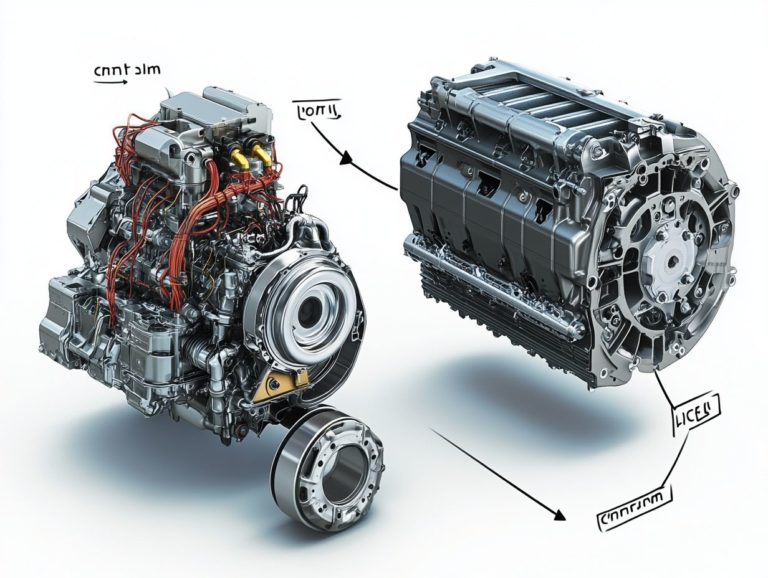Comparing Safety Ratings and Features
When selecting a vehicle, safety frequently emerges as a top priority. Grasping the significance of safety ratings is crucial in empowering you to make well-informed choices among the many choices at your disposal.
Let’s dive into what safety ratings mean and why they matter. This article examines the essential features and technologies that shape them and provides guidance on how to leverage these ratings effectively for comparison purposes.
We also discuss other important factors to consider, equipping you with a comprehensive toolkit for your upcoming car purchase.
Contents
- Key Takeaways:
- Understanding Safety Ratings
- Factors that Affect Safety Ratings
- How to Use Safety Ratings for Comparison
- Other Considerations for Comparing Features
- Frequently Asked Questions
- What are safety ratings and why should I compare them when purchasing a vehicle?
- What is the difference between crash test ratings and overall safety ratings?
- How can I find safety ratings for a specific vehicle?
- What are some common safety features that can affect a vehicle’s safety rating?
- Is a higher safety rating always better?
- Can I compare safety ratings for different vehicle types?
Key Takeaways:
- Safety ratings provide a standardized way to compare the safety features of different vehicles, helping consumers make informed decisions about their purchases.
- Key safety features and technologies, such as airbags and electronic stability control, play a crucial role in determining a vehicle’s safety rating.
- It’s important to consider both safety ratings and features when comparing vehicles, as well as other factors like cost and personal preferences, to make the best decision for your needs.
Understanding Safety Ratings
What Do Safety Ratings Mean?
Understanding Safety Ratings is crucial for anyone like you who wants to make informed choices about vehicle safety, particularly when weighing options such as passenger cars, SUVs, and pickup trucks.
The National Highway Traffic Safety Administration (NHTSA) plays a key role in evaluating vehicle safety, conducting rigorous evaluations that include frontal barrier tests, side pole assessments, and rollover resistance analyses.
These ratings enable you to navigate the vast array of safety technologies and features available in the marketplace, making it easier to understand the key features to compare in cars, ensuring that your decision is well-informed and aligned with your safety priorities.
Safety ratings provide you with a comprehensive evaluation of a vehicle’s crashworthiness (how well a vehicle protects its passengers in a crash) and the associated injury risk, delivering essential information about vehicle safety.
These ratings are established through rigorous testing conducted by independent organizations that simulate various crash scenarios to gauge how effectively a vehicle safeguards its occupants. Key factors include the strength of the vehicle s structure, the efficiency of safety features like airbags and seatbelts, and how well the vehicle performs in collision avoidance measures all crucial in determining its overall score.
Different safety ratings, such as those from the National Highway Traffic Safety Administration (NHTSA) and the Insurance Institute for Highway Safety (IIHS), offer unique insights, highlighting various methodologies and focuses. For you as a consumer, understanding these ratings can profoundly impact your purchasing decisions, as higher scores typically indicate lower injury risks, ultimately leading to greater peace of mind while on the road.
Factors that Affect Safety Ratings
Several factors influence safety ratings for vehicles. These include the class of the vehicle, the incorporation of advanced safety technologies, and the outcomes of crash tests conducted in accordance with Federal motor vehicle safety standards.
Key Features and Technologies
Key features and technologies are essential for enhancing your vehicle’s safety, significantly improving collision ratings and reducing the risk of injury during accidents.
Among these innovations, rear crash prevention systems stand out as critical components. They detect obstacles and alert you, effectively minimizing the chances of backover collisions.
Similarly, advanced airbag systems have made remarkable strides from their early versions. These now use multi-stage deployment methods that adapt to the crash’s severity, ensuring vital protection for you and your passengers.
Additionally, stability control features help maintain your vehicle’s traction, allowing you to stay in control during slippery conditions or sharp turns. Collectively, these advancements not only enhance overall safety but also instill confidence in drivers and passengers alike, contributing to safer roads for everyone.
How to Use Safety Ratings for Comparison
Utilizing safety ratings for vehicle comparison is crucial for making informed decisions. This approach enables you to effortlessly evaluate user ratings of cars with advanced safety features, ensuring that you can choose wisely and prioritize your well-being on the road.
Before you choose your next vehicle, check the safety ratings to ensure you re making a safe choice! Don t wait learn how safety ratings can help you make the best choice for your family!
Interpreting and Applying Safety Ratings
Understanding safety ratings helps you recognize how a vehicle’s score affects insurance losses and safety concerns.
Higher safety ratings usually mean lower insurance premiums, which can save you money over time. For insurance companies, these ratings show risk levels, making it easier to assess the chance of claims based on vehicle crash test results.
When choosing a vehicle, use this information wisely. Pay attention to crash test results, safety features, and long-term reliability to make a smart decision.
By prioritizing vehicles with strong safety ratings, you boost your personal safety and potentially lower your insurance costs.
Other Considerations for Comparing Features
Besides safety ratings, think about other vital factors when comparing vehicle features. It’s important to learn how to evaluate a new car’s safety ratings, check for safety concerns mentioned in public comments, and the recall history for specific models.
These factors can greatly affect your overall assessment and decisions.
Key Factors to Keep in Mind
When it comes to vehicle safety, consider a few important factors. Look at compliance with safety standards, crash test performance, and tire ratings that impact stability.
The quality of tires is crucial for grip, especially in bad weather. Also, evaluate how user-friendly safety technologies, like lane departure warnings and automatic braking systems, are integrated.
Thorough crash test results from trusted organizations provide insights into a vehicle’s ability to protect its occupants. All these components create a complete picture of vehicle safety, guiding your decisions.
Using Safety Ratings and Features for Informed Choices
Using safety ratings along with vehicle features helps you make informed choices. For a comprehensive understanding, check out new car safety ratings to assess injury risks and find vehicles that fit your needs.
By reviewing crash test results, you see how vehicles perform under different conditions. Look at features like advanced driver-assistance systems, comfort, and technology to enhance safety and improve your driving experience.
Resources like online comparison platforms and vehicle reviews offer valuable information. Some apps compile safety ratings from trusted sources, making it easy for you to compare different vehicles.
By using both safety data and feature reviews, you can confidently navigate the car market and choose a vehicle that meets your safety priorities and lifestyle needs.
Frequently Asked Questions
What are safety ratings and why should I compare them when purchasing a vehicle?
Safety ratings measure how well a vehicle protects passengers in a crash. Comparing them helps ensure you choose a vehicle with the best protection for you and your loved ones.
What is the difference between crash test ratings and overall safety ratings?
Crash test ratings assess how well a vehicle protects passengers during simulated accidents. Overall safety ratings consider additional factors, like safety features and technology.
How can I find safety ratings for a specific vehicle?
Search for the vehicle model on websites like the National Highway Traffic Safety Administration (NHTSA) or the Insurance Institute for Highway Safety (IIHS) to find safety ratings.
What are some common safety features that can affect a vehicle’s safety rating?
Common safety features impacting ratings include airbags, anti-lock brakes, electronic stability control, and blind spot monitoring.
Is a higher safety rating always better?
A higher safety rating is generally preferred. However, your personal needs and preferences matter too.
A vehicle with a lower safety rating might offer features that are more important to you.
Can I compare safety ratings for different vehicle types?
Yes, you can compare safety ratings across vehicle types. Remember, these ratings can differ based on the vehicle’s size and weight.






